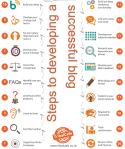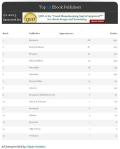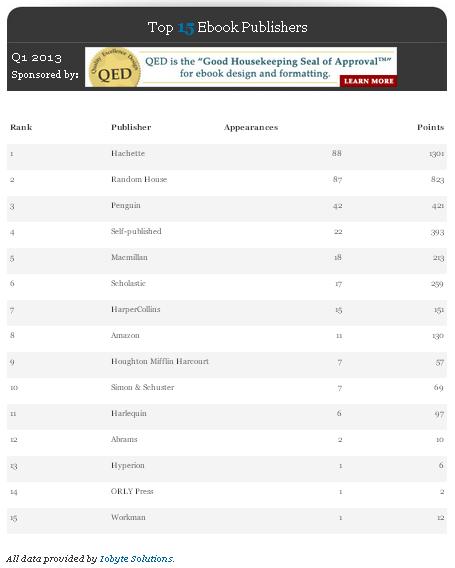
Do you want to improve how you write a blog for business?
Here are 21 tips on how to write a blog for your business blog in a step by step way. Below the how to write a blog for business graphic is a few tips on each step to help you get more clicks, more traffic and build your brand community.

21 Tips On How To Write a Blog For Your Business
My father always used to lecture me of getting the foundations right, getting the research or work done so you know what your doing. As a teenager whilst that was good advice I often ignored it and learnt the hard way (luckily no serious damage was done only some minor accidents e.g. a tree house that fell down with friends and me in it), that this approach did make sense despite my impulse to just jump in and do it.
If you want to learn how to write a blog then you need to understand your customers and write content that they are going to find useful and engaging. Do your homework and you will get more traffic, more click and more leads. But it does take time to get it right and for it to be on target with your customers. You need to prepared to make mistakes and learn from them. Here are 21 tips to help you write a blog for your business blog and get better results.
1 Targeting Your Customers

When you are learning how to write a blog you can easily spread yourself too thin and you will not get the results you are looking for – staying focused is critical.
- Key action – write down who you key target customer is just one e.g. if BtoB: size of business, number of people, turnover, their sectors, greaography…
- narrow down your marketing to niche market/market segments – think long tail here
- Use marketing personas to build out who you are targeting and give them a personality.
- Use any data you have to support your marketing persona e.g. age, demographic data.
- Check with others in the business e.g. sales, customer service – that the persona(s) are right.
2 Find Them Online

Understand where your customers spend time online and you will be able to listen to them and connect in the right places.
- Key action – Write a list of the channels/forums/communities they use e.g. key Linkedin groups
- Look at the demographics e.g. Pew Interest, but then dive deeper…
- Play detective – here is a great article by Jay Baer
3 Social Media Listening

Set a budget for the tools – whilst some are free, the better ones do cost but are worth the investment.
- Key action – choose 1-2 tools and get to know them really well. Budget for them.
- Here are a few social media listening tools
- For a deeper dive into social media listening and monitoring – here is a comparison of the main tools
4 Understand Their Problems

When you are trying to master how to write a blog always put your self in the shoes of your customers. Listen to their problems – what information are they searching for, what service problems do they have, is their misunderstanding about a product or service, do they have wishlists…
- Key action – Write a list of the most common problems, gaps in information and issues
- Prioritise your list
5 Identify How You Can Help Them

This is where you need to be realistic and match what you and your business are good at to their problems.
- Key Action – With the list of problems highlight the ones you are confident that you can write about and fit to your business.
- Draft a list of ideas around each problem – this will be used later
6 Review The Competition

Take into account what your competition are blogging about, what topics tehy are focusing on
Key actions
- Identify their key topics e.g. categories on their blog page
- See what posts have been popular and assess why
- Identify how you can be different / better than them
- Don’t be a copy cat
7 Identify How You Can Help Them

What do you stand for and why should people follow your – what is the core message that will attract and be relevant to your audience.
Key Actions
- Develop an easy strap line that helps people understand what your about
- Build your message into your blogs and communications
8 Set Your Goals, Objectives and Metrics

This is the critical part. If you are going to invest in blogging set your self some clear goals for the results. What do you want to achieve (be realistic) and what business benefit will it deliver e.g. 5 leads per week.
Key Actions
- Use SMART objectives (specific, measurable, achievable, realistic and timed)
- Be sure you can measure them
- Produce a spreadsheet and plan out your targets by week/month and then your results
9 Develop Your Strategy and Tactics

Plan in the strategy that is going to work for you – how your blog content fits to your overall marketing plan and communications mix.
Key actions
- What are the key resources and actions needed to achieve your goals?
- What are the daily/weekly tasks you are going to schedule?
10 Build Your Blog

A good blog needs a good home. Invest in a WordPress blog that is going to fit to your brand and be easy for people to engage with.
Key actions
- Make sure you choose a responsive theme – the rise of the mobile consumer is here see these stats
- Build in the styles and design features that can help your blog stand out
- Blogs are increasing becoming more visual so add in the styling that will help you produce a good visual layout – think more magazine than blog
11 Build Out Marketing Functionality

Your blog needs to be able to turn traffic into buying customers and to do that you need to have the right marketing functionality. Looking good is not enough.
Key actions
- Build in your key conversion points and methods to convert customers
- Add in tracking e.g. goals so you can measure performance
12 Link Your Social and Email

Key actions:
- Hook up your blog with your social networks so that people can easily share your content.
- Also build in your email subscriptions to build your email list.
13 Develop Your Editorial Calendar

This is probably on of the most important steps. An editorial calendar will help stay focused and give you a good schedule to work to. It is even more important if you have more than 1 person in your business blogging.
Key actions
- Be realistic and don’t forget to add in the other content that you are producing
- Balance out your categories to make it more varied and interesting for your audience
14 Research Your Keywords and Phrases

Key actions
- Do you keyword research and focus on the long tail keywords and phrases for your niche
- Optimise your on page SEO as well for each post e.g. use Yoasts WordPress SEO plugin
15 Develop Your Killer Headlines

Your titles make the difference between a click and no-click a share and just a read. Spend time coming up with awessome titles.
Key actions
Key Actions
- Think like a magazine editor here
- Download our content marketing guide and use our list of formulas for killer headlines
16 Write Your Blog and Format

Write your blogs and rewrite them. Find your own personal voice and practice – it takes to to develop a writing style that is right for you. Write as if you are talking to your marketing persona and helping them.
Key actions
- Don’t be afraid – everyone goes through times of uncertainty and doubt when writing. It can be hard but bit by bit you will improve
- Remember there is only one you and that is unique and special use it to to your advantage and intertwine the personal and business
- End each post with a call to action or ask for people’s opinions
17 Publish To Your Social Networks

You have to promote your blog and ensure it is found.
Key actions
- Publish to your main social networks and invite comments and feedback
18 Respond To Comments

Comments are the gold of blogging and so actively invite comments and always respond promptly to them
- Use a good commenting system such as Disqus
- Respond and be helpful, never rude. Remove any spam to keep you blog clean
19 Track Your Performance

With each blog post you move one step closer to achieving your goals. Track your metrics and review regularly.
20 Rinse and Repeat – Improve

Some blog posts will do well whilst others may not achieve the results you had hoped for. Learn from your spikes and dips and continually refine your editorial calendar to improve titles, content and how you reach and attract your audience. Importantly make sure you are turning your blog into tangible business results.
21 Don’t Forget To Enjoy It and Be Creative

This may seem obvious but have fun, enjoy it and if you are passionate about helping people and equally enthusiastic about your business your blog will do well. Experiment by adding in different media and help to make your business human. Your customers will appreciate being part of your tribe.
ᔥVisit original post here.
Related articles
- 21 Quick Tips On How to Write A Blog For Your Business (tribalcafe.co.uk)
- Blogging for Business: Target Markets (business2community.com)
- Take Charge of Your Content Strategy (business2community.com)
- Why Your Business Needs A Blogging Strategy (tweakyourbiz.com)
- 10 Reasons Why Your Business Shouldn’t Start Blogging (tribalcafe.co.uk)
- Five Things You Need to Know Before Starting a Business Blog (business2community.com)






 When writing a book, there is no rule of thumb on the number of pages or its chapter length, regardless of genre. However, there are some important things that you need to keep in mind when determining your book’s
When writing a book, there is no rule of thumb on the number of pages or its chapter length, regardless of genre. However, there are some important things that you need to keep in mind when determining your book’s 